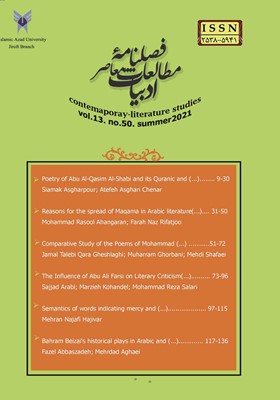-
-
List of Articles
-
Open Access Article
1 - Poetry of Abu Al-Qasim Al-Shabi and its Quranic and romantic themes
Siamak Asgharpour Atefeh Asghari Chenar -
Open Access Article
2 - Reasons for the spread of Maqama in Arabic literature and its disappearance in the contemporary period and its limitation to Persian literature
Mohammad Rasool Ahangaran Farah Naz Rifatjoo -
Open Access Article
3 - Comparative Study of the Poems of Mohammad Hossein Shahriyar and Nazak al-Malaeka from the Perspective of Social Criticism
Jamal Talebi Qara Gheshlaghi Muharram Ghorbani Mehdi Shafaei -
Open Access Article
4 - The Influence of Abu Ali Farsi on Literary Criticism and Contemporary Critical Theories
Sajjad Arabi Marzieh Kohandel Mohammad Reza Salari -
Open Access Article
5 - Semantics of words indicating mercy and forgiveness in Hatam Taei's poetry; Semantic research
Mehran Najafi Hajivar -
Open Access Article
6 - Bahram Beizai's historical plays in Arabic and Persian literature
Fazel Abbaszadeh Mehrdad Aghaei
-
The rights to this website are owned by the Raimag Press Management System.
Copyright © 2021-2025







